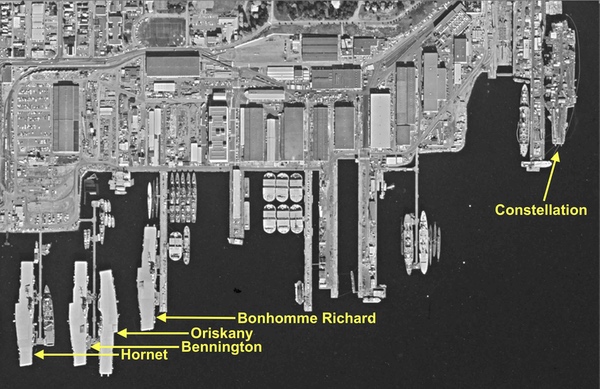Carriers from space (part 2): Contemporary use of satellite imagery for open source intelligenceby Dwayne A. Day
|
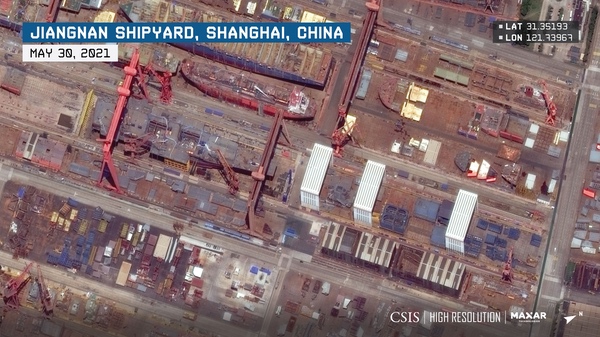 The Center for Strategic and International Studies closely followed the construction of China's third aircraft carrier, its first of Chinese design. In May 2021, a Maxar satellite photographed the ship under construction in Jiangnan Shipyard, Shanghai, China. Individual ship components were assembled nearby and lifted onto the ship with massive cranes. (credit: Maxar via CSIS) |
The third Chinese aircraft carrier was the first of China’s own design, and significantly bigger and more capable than the first two. China’s first two carriers can only deploy a small number of planes that have limited range and payload capability. The new ship will obviously significantly expand its embarked aircraft and have a greater ability to project power than Liaoning or Shandong. That new ship’s construction and early operations have been tracked by Westerners using commercial satellite imagery that has proliferated in the past decade.
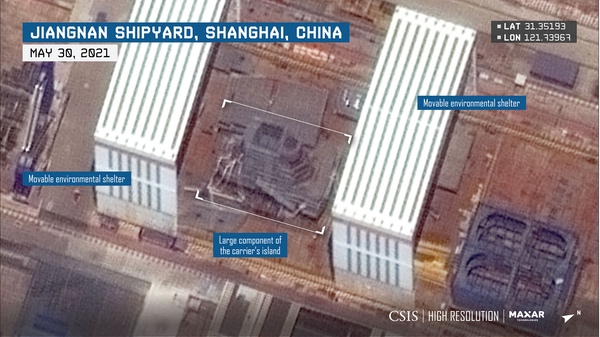 The carrier's island was visible under construction inside the large dry-dock facility. The presence of exhaust ducting in the island structure confirmed that the carrier would be conventionally powered. (credit: Maxar via CSIS) |
“Carrier 003” began construction at Shanghai’s Jiangnan Shipyard around 2017 and took shape over the next several years inside its large drydock facility. During this time, open source—“OSINT”—analysts kept track of the ship’s construction using commercially available satellite imagery. Carrier 003 was the most visible and interesting aspect of a major Chinese naval fleet expansion.
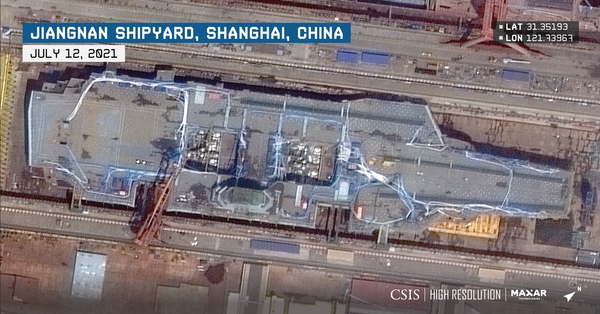 In July 2021, the carrier's deck was criss-crossed with ventilation ducts to pump fresh air inside. (credit: Maxar via CSIS) |
OSINT analysts kept track of Carrier 003 under construction, noting by spring 2022 that the ship’s large aircraft elevators had been installed. They also noticed that unlike the two previous ships, Liaoning and Shandong, which had ski-jump ramps at their bows for launching planes, Carrier 003 had a flat deck, and what they quickly identified as catapults. Catapults make it possible for a ship to launch heavier aircraft than ski-jumps. Soon the ship’s electromagnetic catapults were installed—a technology that the US Navy has only recently perfected and is used in only a single US Navy nuclear-powered aircraft carrier. Although China still has to make electromagnetic catapults work reliably at sea, the country has managed to completely leap past nearly a century of carrier operations with hydraulic and then steam catapults to the most modern technology.
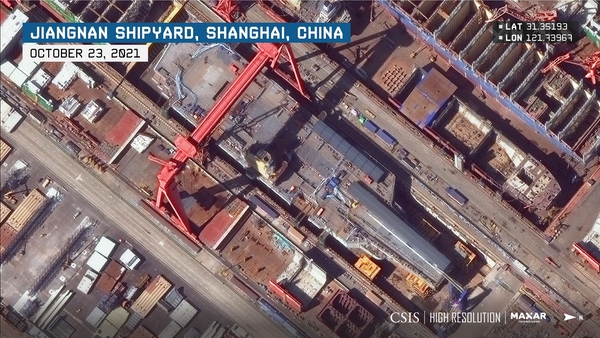 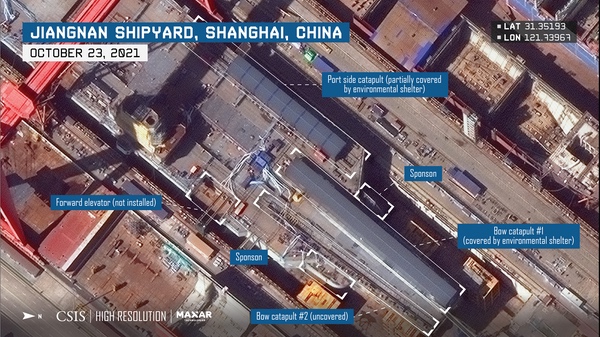 In satellite imagery taken in October 2021, further details of the ship's construction could be seen. The ship's island was in place and its electromagnetic catapults were being installed. The catapults represent a major advance for China; only the United States Navy’s latest carrier uses this technology. (credit: Maxar via CSIS) |
By June 2022, commercial satellite images showed that Chinese workers were flooding the drydock with the new carrier. A few days later the ship was floated out. It was also publicly named Fujian. China for the first time released ground-level photos of the ship, looking pristine from a fresh coat of paint, not yet soiled by aircraft exhaust and tire skid marks.
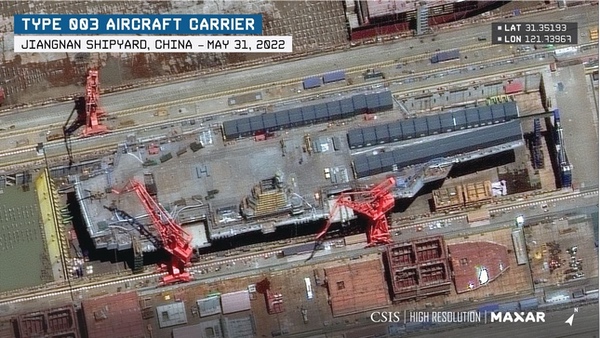 In May 2022 the carrier was imaged again. By this time the flight deck was nearly finished structurally, but significant work remained. However, open source intelligence analysts speculated that the ship would soon be floated out of drydock. (credit: Maxar via CSIS) |
Drydocks also provide intelligence on a carrier’s readiness state. While Fujian was under construction, Shandong went into drydock for maintenance. Decades of US Navy experience have demonstrated that three carriers are necessary to keep one deployed. More importantly, analysts also noted the construction of another new dry-dock that was apparently for servicing the earlier ships as well as Fujian once in service.
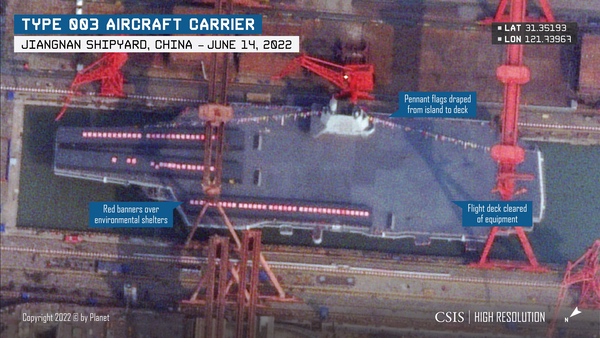 In June 2022 the carrier had left its drydock. The pennant flags visible in this satellite image by Planet indicated that the ship was about to be officially accepted by the Peoples’ Liberation Army Navy, although it was still years from entering operational service. At this time it was named Fujian. (credit: Planet via CSIS) |
Meanwhile, Russia was preparing an overhaul of its problem-plagued carrier Kuznetsov, the only carrier in the Russian fleet, but a ship that had been barely operational in three decades of service. However, before any major work could be performed on the ship’s hull, workers had to modify a drydock to handle the ship. Some of that drydock preparation was monitored by OSINT analysts using satellite imagery.
OSINT analysts following Fujian’s construction sometimes noticed interesting details. For instance, an orange object was spotted at a ground facility for testing aircraft catapults. They speculated that the object was a “dead load test vehicle” intended to simulate the mass of an aircraft being propelled by the catapult. The US Navy uses similar devices for testing the catapults of its carriers. Later an orange object was spotted on Fujian’s deck in low-resolution satellite photos, and soon ground-level photos proved that it was indeed a dead load test vehicle. A barge that had been moored in front of the carrier was moved out of the way, indicating that the test vehicles would soon be fired off the deck into the water, which did happen.
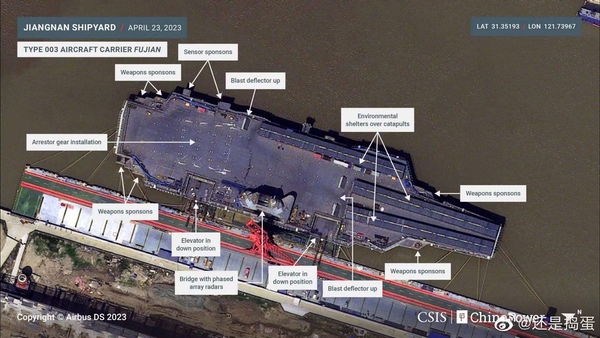 Fujian in April 2023, imaged by an Airbus satellite. The Center for Strategic and International Studies noted that the carrier was still under construction. The ship did not put to sea until spring/summer 2024. (credit: Airbus via CSIS) |
One development in recent years has been the availability of commercial synthetic aperture radar (SAR) images. The primary value of SAR images is that SAR can peer through clouds and darkness. OSINT analysts have in recent years begun tapping into commercially available SAR images to keep tabs on military developments around the world. But this fancy new tool was not necessary for monitoring a ship under construction in a drydock that was usually not obscured by clouds. Proving that turnabout is fair play, in April 2024, a Chinese company released commercial SAR images of Naval Station Norfolk, revealing three American aircraft carriers at their Norfolk piers, over six decades since the first satellite photo of an aircraft carrier was taken. (See “Carriers from space (part 1),” The Space Review, July 15, 2024.)
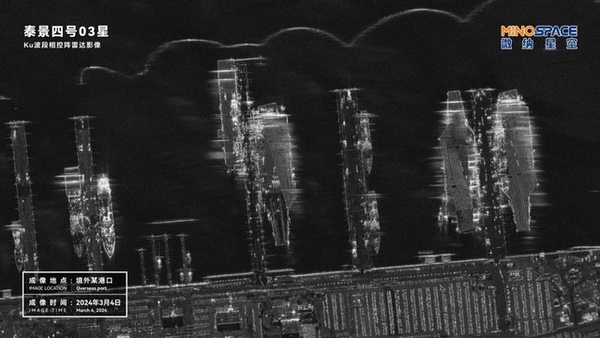 Chinese satellite manufacturer MinoSpace released this synthetic aperture radar image of US Navy aircraft carriers at Naval Station Norfolk in March 2024. (credit: MinoSpace) |
Also in April 2024, Fujian started sea trials. OSINT analysts used satellite images to gather data on the ship. In one low resolution satellite image the ship’s wake can be seen in a figure-eight shape, indicating that it was making high-speed turns at sea. Such maneuvering is used to test the engines and rudders on a ship, as well as to assess its overall handling qualities.
In another recent satellite image, Fujian was seen moving backwards, another test of its engines that was probably very uncomfortable for the crew. After those sea trials, Fujian was spotted back at its dock, undoubtedly undergoing further testing and construction. In mid-July, Fujian went back to sea and satellite photos showed that the ship had three aircraft, or aircraft mockups, on the flight deck. But over several days, those aircraft did not move, indicating that the ship is not yet performing flight tests.
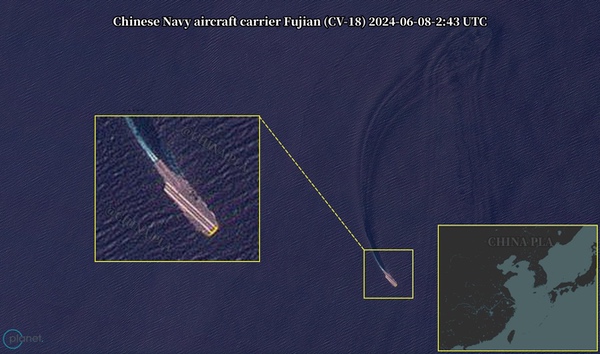 In June 2024, a Planet satellite photographed the Fujian moving backwards at sea during trials. Such maneuvers are used to test the ship's engines and related systems. (credit: Planet) |
It will be several years before Fujian and its crew are fully operational. But now that it can put to sea, there are other ways to keep track of her. Analysts will be closely watching the large dry-dock where Fujian was constructed, looking for signs of China’s fourth aircraft carrier.
Although the availability of commercial satellite imagery has proven to be a boon to Western open-source intelligence analysts, there is also reason to believe that China is taking advantage of it as well. Recently, news emerged that China is using software to detect the wakes of American aircraft carriers when they appear in low resolution commercial satellite images, providing data on their location and heading.
China is just starting its carrier fleet, and has a long way to go. The United States Navy has operated more than 150 aircraft carriers of all sizes, not to mention helicopter carriers, and launched and recovered aircraft millions of times over nearly a century of carrier aviation. An October 1983 HEXAGON satellite photo helps make the case. It showed five US Navy aircraft carriers moored at Bremerton, Washington. One of those ships, USS Hornet, would eventually become a museum. Another, USS Oriskany, was sunk in Florida waters to serve as a diving attraction. Two others were scrapped. Nearby, USS Constellation was undergoing refit and would continue to serve another two decades before being retired. The US Navy has a tremendous history of building and operating aircraft carriers. Now other navies, particularly China’s, are seeking to emulate it.
Note: we are now moderating comments. There will be a delay in posting comments and no guarantee that all submitted comments will be posted.
